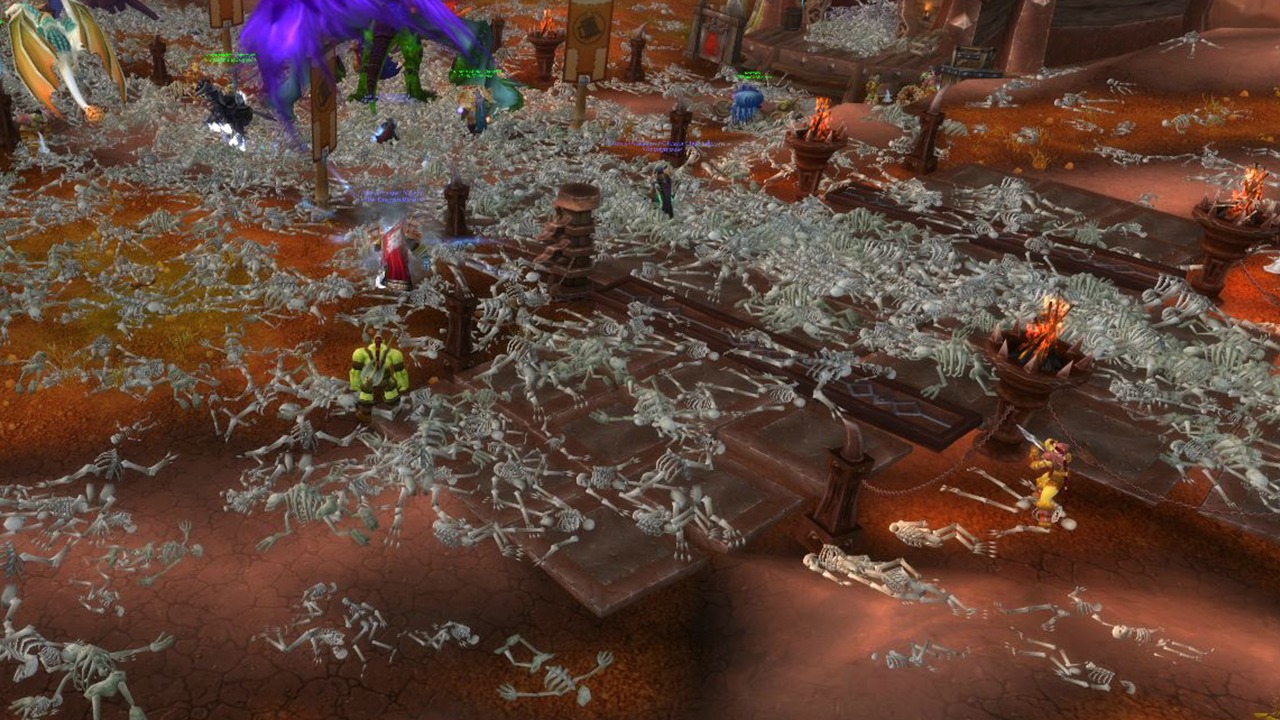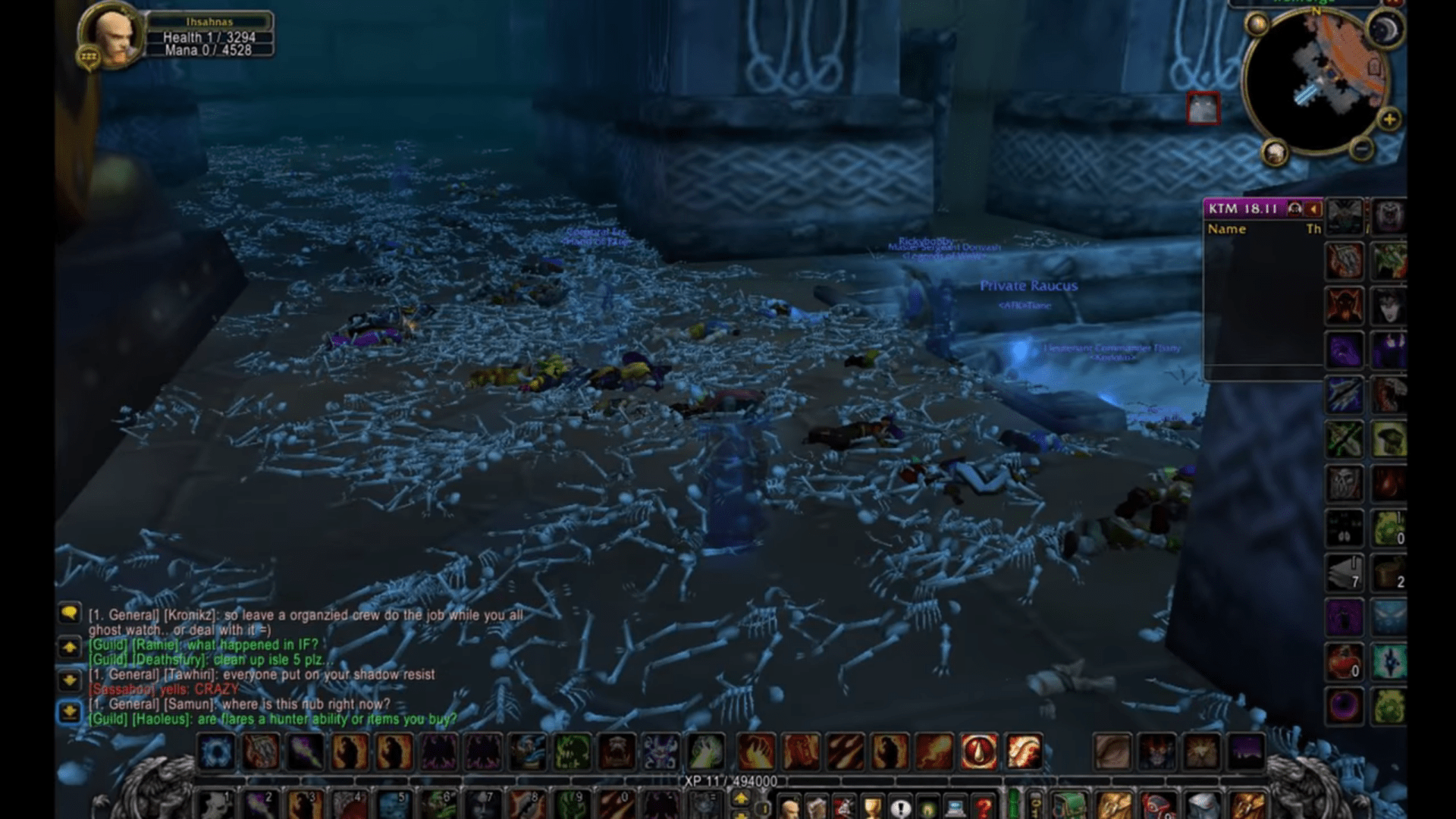To See How Coronavirus Outbreak Might Play Out, Look at This Virtual Plague

By Gurwinder Bhogal
Staff Writer
1/2/2020

Skeletons of victims of the Corrupted Blood disease litter a population center
Some will have it to be in the nature of the disease…that it impresses every one that is seized upon by it with a kind of rage and a hatred against their own kind, as if there were a malignity, not only in the distemper to communicate itself, but in the very nature of man.
— Daniel Defoe, History of the Plague in England
On Thursday the World Health Organization declared the Wuhan coronavirus a global health emergency. In less than a month there have been 9,700 confirmed cases — more than the SARS virus infected in the course of its entire epidemic — and there are currently over 12,000 additional suspected cases, with the numbers expected to rise far higher as the virus spreads outside China.
Experts are using sophisticated computer models to try to predict how this “unprecedented” new outbreak will play out. But the best way to predict how the outbreak will play out may actually be to look at a computer game, one which was never supposed to involve pathogens, but which came to be a case study for how pandemics affect human behavior.
Epidemiologists currently use three general models to simulate disastrous outbreaks of disease: compartmental models, network models, and agent-based models. Compartmental models, the simplest approach, divide populations into fractions, like the proportion that are susceptible to a pathogen and the proportion that are infected. Agent-based models use a computational approach in which entities with a specified set of characteristics interact according to predefined rules. Network models, the most complex approach, compute probabilistic associations between agents to model infections directly.
These models each have their own pros and cons, but all share the same fatal flaw: they assume that human behavior is largely rational and based on simple, unchanging rules. They also depend on data gleaned from humans acting in normal, safe conditions, and do not reflect the behavior of humans in extremis, because there has rarely been an opportunity to study humans in the midst of a viral apocalypse.
Epidemiological models are limited by the assumption that human behavior is largely rational and based on simple, unchanging rules.
It’s notable, then, that there was once a virtual viral apocalypse — one created completely by accident — which managed to capture human behavior in all its wild, incomputable derangement, and which now offers disturbing insights into how the coronavirus outbreak may play out.
The event occurred in the popular online role-playing game World of Warcraft (WoW), in which players create a character and use it to explore a detailed high-fantasy world, fighting, trading, building relationships, and completing quests. Characters can also own pets – creatures like bears or wyverns that can accompany them through the game.
In 2005, the game’s developer, Blizzard, created a new mission for the game’s 4 million players in the temple city of Zul’Gurub, which culminated with a battle against a new boss creature, Hakkar the Soulflayer.

Hakkar the Soulflayer
Hakkar had a special attack that infected players with a disease called “Corrupted Blood,” which sapped their health for a period of time and spread to other nearby players. Players who had survived the disease could then re-contract it through proximity to infected players. The game’s programmers intended the infection to remain in the region of Zul’Gurub, but they overlooked something: players’ pets could also be infected, and if they were dismissed by players while infected, they would retain Corrupted Blood indefinitely until they were resummoned again.
Oblivious to this, players returned to the cities in triumph after having slain Hakkar. Many would then summon their infected pets in a bustling town square, and their triumph would turn to horror as they and everyone around them began losing health and dying. From there the plague quickly swept across the game’s world, and over the course of a week it killed tens of thousands of players, their polygon corpses and skeletons littering the towns, cities, and plains.

The apocalypse was unintentional and Blizzard had no plan to simulate real life epidemics, but from the outset there were uncanny commonalities between the Corrupted Blood plague and real-life outbreaks like the coronavirus.
Firstly, both diseases originated in animals and were zoonotic (transmittable from animals to humans). Corrupted Blood was initially spread by players’ pets. The coronavirus is believed to have originated in bats, though some assert it was passed from bats to humans through snakes (incidentally, the progenitor of Corrupted Blood, Hakkar, is a chimera of snake and bat).
Corrupted Blood and the coronavirus also spread in similar ways among humans. Both diseases were transmitted between cities by transit (in WoW via the teleport feature and in the real world via rail and airliner), and they were transmitted within cities through commercial trade (in China via a Wuhan wet-market, and in WoW via the auction house and bank).
One way Corrupted Blood spread through trade was through non-player characters like shopkeepers. These are unkillable and were able to carry the disease asymptomatically (i.e. without exhibiting outward signs of the disease). It is now known that the coronavirus was also spread by asymptomatic carriers, whose apparent normality makes them hard to guard against.
Not only did Corrupted Blood behave like the coronavirus, but humans initially reacted to both in very similar ways, which were not far from the rational computer models of epidemiologists.
For instance, when WoW players learned of the epidemic, most fled the densely populated areas or shut themselves away from everyone, leaving the town centers largely empty. The streets of central Wuhan are now also largely deserted for the same reason.
One way that WoW players tried to combat the plague was by setting up quarantine zones within and between cities. Players would stand guard in such zones, warning away anyone who tried to cross. Quarantine zones have also been set up throughout China and at many airports around the world.

Thermal monitoring station to screen passengers at Shanghai Pudong International Airport
Another way WoW players tried to fight the plague was through healing. Characters with health-restoring abilities like priests and paladins (holy knights) volunteered their services in high-infection areas, working in shifts to treat victims. In China, healthcare workers are doing much the same thing, and the Chinese government has even ordered the rapid construction of two new hospitals to treat the infected.
So far so expected. Perhaps the computer simulations were right after all, and human reactions to viral catastrophes are reasonable and predictable.
Except, things soon took a strange turn: players began behaving in ways that defy reason.
Players began behaving in ways that defy reason.
The first signs of trouble came early in the Corrupted Blood epidemic, when players ignored Blizzard’s advice to stay away from populated areas. Many in fact did the opposite, venturing toward the epidemic to take a look, only to then contract the plague and spread it further. Some went so far as to deliberately contract the plague to “experience” it. For these reasons the quarantines that had been set up to contain the outbreak were quickly breached.
Epidemiologist Nina Fefferman, who studied this incident, said that this behavior ran contrary to computer simulations of outbreaks, which assumed people would simply try to escape the contagion.
But this was just the beginning. As the plague infected players’ characters, the idea of the plague began to infect players’ minds, inhibiting their rationality. Hysteria and paranoia became common. On message boards conspiracy theories about the plague began to coalesce, with the most common being that the plague had been deliberately released by Blizzard to test players. Some believed it had been an act of sabotage by a disgruntled employee.
The suspicion wasn’t just restricted to Blizzard. Many players became wary of the character class known as hunters, blaming them for the plague due to their close association with pets. Hunters are not the only class able to summon pets, but because they’re the class most likely to have pets, they were singled out, becoming ostracized by many players as a result.

A dwarven hunter with his pet bear
Perhaps the most irrational and disturbing behavior exhibited during the plague was “griefing.” This is a form of trolling wherein players in a video game deliberately defy the rules to make life difficult for other players. In one incident, the community proposed a plan to have everyone who was infected flag themselves as infected so others knew to stay away. This system quickly broke down, because some infected players refused to flag themselves, presumably so they could ambush others with infection for fun. In response, many who were uninfected flagged themselves as infected so that no one would try to infect them.
In the end, some players became so sick of getting sick that they began to desperately seek out ways to become invulnerable to infection. But these desperate players fell victim to a different kind of predator: scammers peddling fake cures.
It may seem like the irrational behavior during the Corrupted Blood incident won’t manifest in the real world. After all, the stakes in a video game are comparatively trivial, so the cost of trolling behavior is much lower. The relative lack of real consequence means people behave in ways in a game that they would never dream of in the real world, like slaughtering a group of strangers just because they can.
But this line of reasoning makes the same mistake as the epidemiological models: it assumes that human behavior in the real world is rational. When people play games that are as immersive as WoW, games that require significant investment of time and money, and which result in real relationships, real forms of social status, and real emotions, the mind is rarely able to distinguish the actual and virtual.
And when one looks at how people are currently responding to the coronavirus, one finds parallels to the disturbingly irrational behavior that resulted from the Corrupted Blood plague.
One finds parallels to the disturbingly irrational behavior that resulted from the Corrupted Blood plague.
Just as some WoW players disobeyed Blizzard’s instructions and ventured into high-infection areas, so people have been defying the Chinese government’s instructions and venturing through Wuhan, making YouTube videos of their exploits.
Just as WoW players used subterfuge to breach quarantine zones, so people in the real world have been doing the same, like the woman who took pills to reduce her fever so she could bypass airport security and leave China for France for holiday, displaying a callous disregard for others reminiscent of the infamous “Typhoid Mary.”
Just as WoW players concocted conspiracy theories about Corrupted Blood being intentionally released by Blizzard, so conspiracy theories have begun to emerge in the real world about the coronavirus being intentionally released by the US government to sabotage China.
People are now also offering fake cures for the coronavirus, with anti-vaxxers claiming that the disease can be cured with oregano oil, and QAnon conspiracy theorists claiming the best remedy is to drink bleach.
Just as WoW players scapegoated and ostracized hunters for the Corrupted Blood plague, so people in the real world have begun scapegoating and ostracizing people of Chinese ethnicity.

Just as WoW players engaged in “griefing” by trying to infect others with Corrupted Blood, so people in the real world have tried to infect others with the coronavirus. There have been disturbing stories of patients pulling away doctors’ surgical masks and spitting in their faces, and people spitting on elevator buttons. It’s unknown whether these stories are true, but people have been known to deliberately spread deadly diseases like HIV in the past, and Chinese police are taking the possibility seriously enough to issue penalties for anyone caught trying to spread the virus.
Thankfully, most of these behaviors are rare. But the exponential nature of infection means that even rare behaviors can have a big impact. A notable example is “super-spreaders,” ultra-infectious individuals who wrought havoc during the SARS epidemic and whose presence can single-handedly cause epidemics to approach a Pareto distribution in which 80% of infections are caused by 20% of infected individuals. Humans exhibit a wide range of rare behaviors during a viral pandemic, and while each behavior is an exception rather than the rule, there are so many different exceptions that they effectively change the rules.
The exponential nature of infection means that even rare behaviors can have a big impact.
It should be noted that the unpredictability of human populations is probably not a bug, but a feature. Evolution favors caprice; viruses that can rapidly mutate are harder to vaccinate against, and human populations that exhibit a wide range of individual behaviors are more resilient to change. There is also, however, a downside to this unpredictability; whilst it makes humans hard to harm, it also makes them hard to help.
So how can we be helped? How do we restore order when we are not only trying to second-guess the virus, but also ourselves?
The Corrupted Blood plague was finally defeated when Blizzard literally changed the rules of their game with a patch that prevented pets carrying the virus beyond Zul’Gurub and reduced the duration of the infection. Unfortunately, the rules of reality cannot be so easily changed. And yet, even Blizzard’s solution has important lessons for dealing with the coronavirus.
Blizzard was able to beat the plague because data travels much faster than any virus, allowing programmers to coordinate across servers and root out the cause of the contagion in a matter of days. Likewise, the world’s health organizations are currently sharing information on the coronavirus, including even the usually secretive Chinese government. As a result, scientists in Australia have now managed to recreate the virus from its genome, a crucial step towards developing a vaccine.

Medical model of the coronavirus
The Corrupted Blood incident, a 15-year-old bug in a video game with elves and orcs, does not enable us to predict how humanity will react to a real viral apocalypse. But it does show us exactly how unpredictable we could be. It shows us that in a time of crisis we do not follow the established rules of epidemiological models, or even of common sense. It shows us that we often act against our own interests, and those of others, for seemingly no better reason than because we can.
But, encouragingly, it also shows us that sometimes, all that’s required to restore us to order is the intervention of a rational few.
Related posts:
Modi and His Supporters Face a COVID Reckoning
Tablighi Superspreaders in Pakistan
The Culture Factor in COVID-19
The Moral Foundations of Anti-Lockdown Anger
Are Anti-Lockdown Protests Legal?
Allegory in the Time of Coronavirus
Your Odds of Dying From COVID-19 Depend on How Polluted Your Air Is
Japanese Culture Isn’t Designed to Handle a Pandemic
The Coronavirus and the Crisis of Responsibility
FAKE NEWS | Nothing to Worry About, Says Wuhan Official From Inside Biohazard Suit
